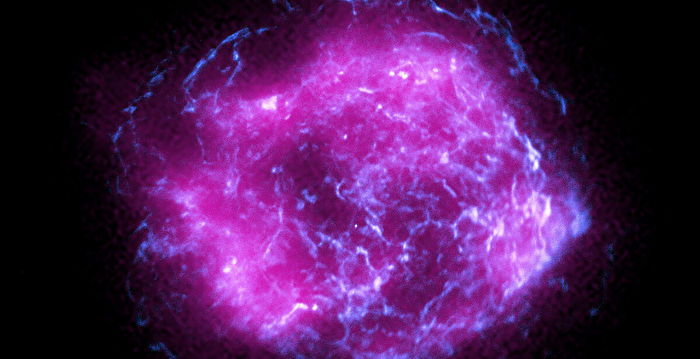【The Epoch Times, March 5, 2022】(The Epoch Times reporter Zhang Yufei reported) After the commissioning of NASA’s X-ray Imaging Polarization Probe (IXPE), the first space photo has been sent, revealing the process of a supernova explosion. It seems that afterglow four Shoot, very spectacular.
On December 9, 2021, a SpaceX Falcon 9 rocket launched the IXPE into a low-Earth orbit at an altitude of 370 miles (600 kilometers), with a planned operation for two years. After a month-long debugging and proofreading, IXPE slowly adapted to the space environment and finally began collecting scientific data in mid-January 2022.
All of the instruments on the space observatory are working well and are currently studying some of the most mysterious and extreme objects in the universe, NASA said in a press release.
IXPE first took aim at the most popular target among space observatories, Cassiopeia A, the remnant of a star that exploded in the 17th century, but only now has electromagnetic waves reaching Earth. It is the youngest known supernova remnant in our galaxy.
The shock waves from the explosion swept the surrounding gas, heating it to high temperatures and accelerating cosmic ray particles, creating a cloud that emits X-rays.
For comparison, the NASA team superimposed the first X-ray data collected by IXPE (magenta) with earlier observations from the Chandra X-ray Observatory (blue). Chandra and IXPE are equipped with different types of detectors that can capture different levels of angular resolution, or sharpness, and combining the two can yield more complete and detailed data about high-energy sources in the universe.
Launched in 1999, NASA’s Chandra Observatory was dubbed the “Hubble of X-rays”. It was the most powerful X-ray telescope at the time and is still in high Earth orbit. It also took the first image of Cassiopeia A, the youngest supernova remnant in the Milky Way.
“The images captured this time are as historic as the previous ones,” said Martin Weisskopf, principal investigator for IXPE at NASA’s Marshall Space Flight Center, where the team is now analyzing all the data to learn more.
The wavelength of X-rays is so short that, although invisible to the human eye, it is astronomically significant. There are some celestial bodies in the universe (such as black holes, neutron stars, etc.) that emit almost no visible light, but can emit “bright” X-rays and reveal important information about the magnetic field of celestial bodies and the geometry of celestial bodies. Because Earth’s atmosphere blocks cosmic rays from reaching the ground, X-rays can only be collected by telescopes in space.

With polarization data from Cassiopeia A, IXPE will allow scientists to see for the first time how the amount of polarization changes in a supernova remnant about 10 light-years in diameter, NASA said, and researchers are now using the data to map The first image of the object’s X-ray polarization, which will provide new clues about how Cassiopeia A’s X-rays are produced.
“Future polarization images from IXPE should reveal the core mechanisms of this well-known cosmic accelerator,” said Roger Romani, co-investigator at IXPE at Stanford University. “To fill in some of these details, we have developed a One way to use machine learning techniques to make IXPE measurements more precise. We’re really looking forward to what we’ll find when we analyze all the data.”
IXPE, a joint effort by NASA and the Italian Space Agency, will spend the next two years studying some of the most mysterious and energetic objects in the universe, including the remnants of stellar explosions, black hole particle jets, neutron stars and Nebula, etc.
Responsible editor: Han Yu#
